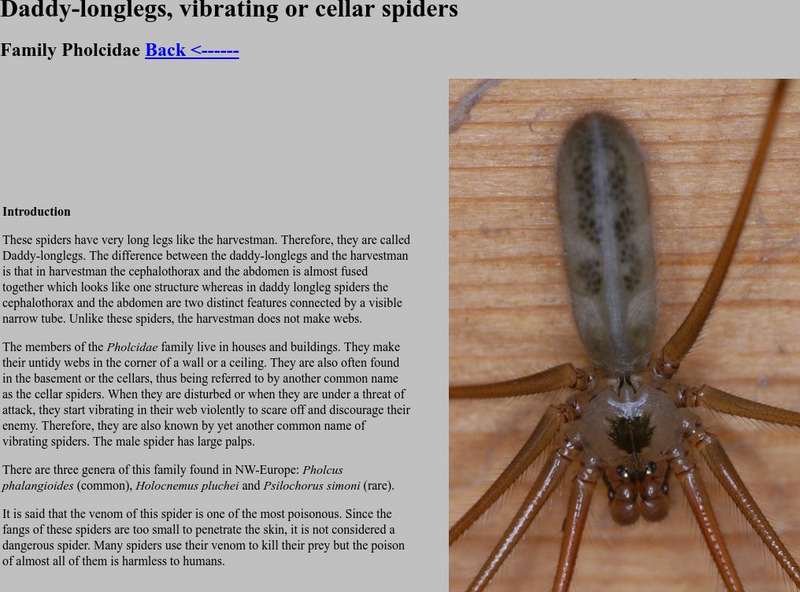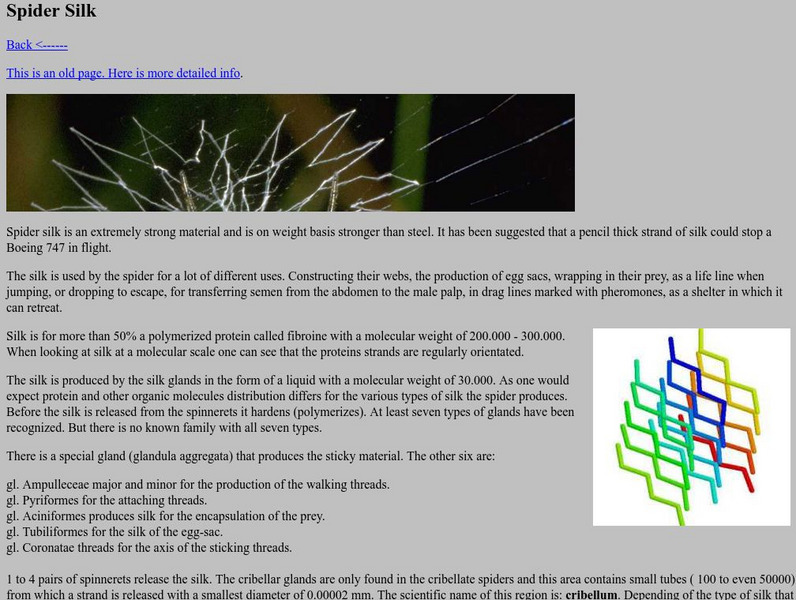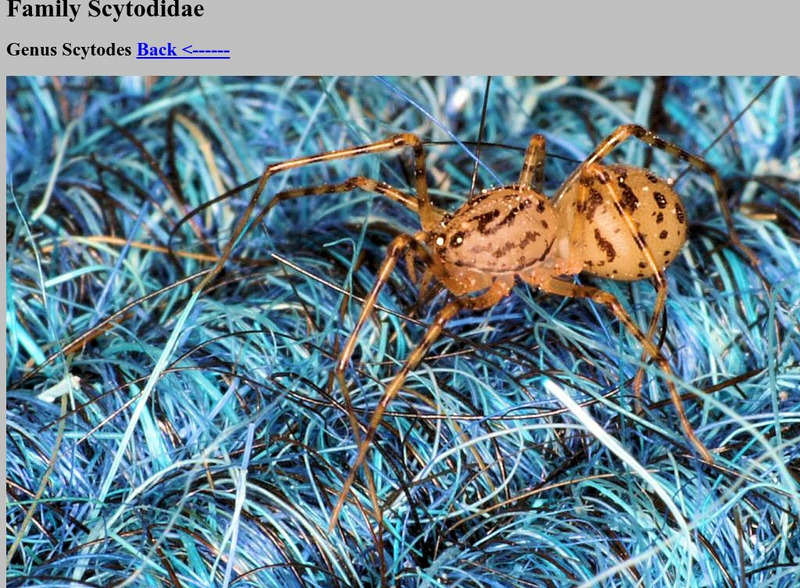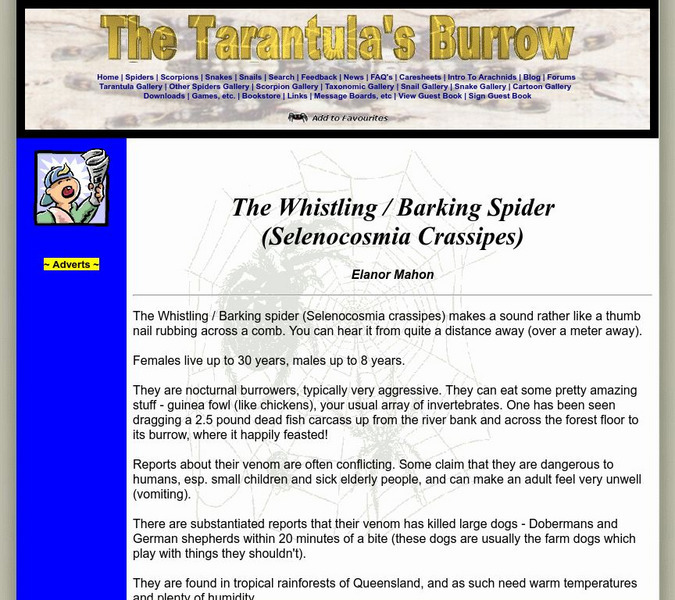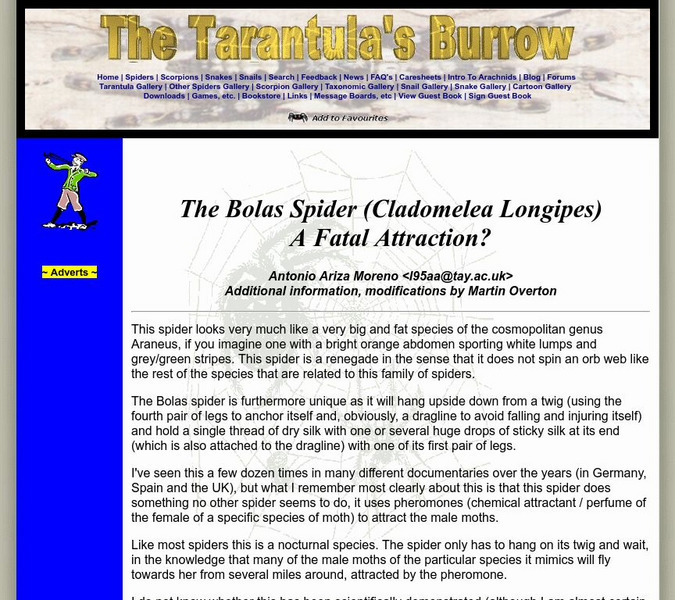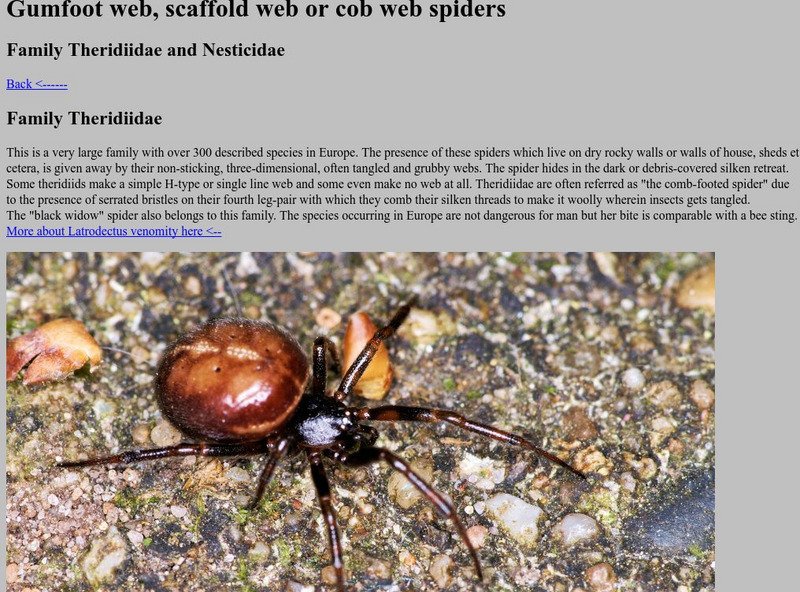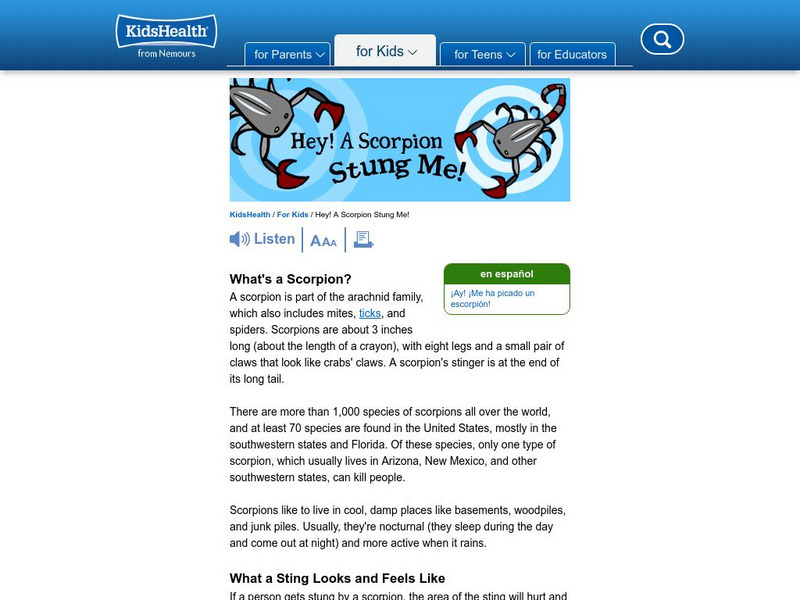Other
The Daddy Long Leg
A page devoted to the life of the daddy long-leg. Explains things such as its life-span, mating habits, preying method, etc.
Other
Ed Nieuwenhuys' Spiders & Immunology: Spider Silk
An informative site on the properties of spider silk, including its surprising strength and how it's produced.
Other
Family Scytodidae
A web site on the family of scytodidae. Includes information about qualities specific to this family of spiders. Contains multiple pictures and a diagram.
Other
Tb: Spiders Considered as Medically Important
This article investigates how humans vary in their vulnerability to venomous spiders and the importance of certain spiders to medical research. It investigates what factors contribute to this difference.
Other
The Tarantula's Burrow: The Whistling / Barking Spider
A quick overview on the whistling spider which is found predominantly in Australia. Includes reports on their ability to make noise and the effects of their bites.
Other
Arachnaphiliac: The Bola Spider a Fatal Attraction?
A site on the unique bola spider, which uses pheromones in order to catch its prey, male moths.
Other
Arachnophiliac: Sun, Wind Scorpions Aka Solufigids
A site on the sun and wind scorpion species. They are not actually a scorpions, and they don't like the sun. A description with pictures. Discusses habitat.
Other
Araneae, Spiders of North West Europe: Purse Web Spiders
A detailed description of the primitive purse-web spider. Includes pictures and information on how it catches its prey
Other
Araneae, Spiders of Europe: Family Amaurobiidae
Multiple colorful pictures bring this web site to life. Contains information on the mating and preying habits of the amaurobiidae, otherwise known as the tunnel weavers.
Other
Araneae, Spiders of North West Europe: Crab Spiders
A study of the crab spider family eusparassidae. includes a pictomentary of the growth of a Micrommata virescens.
Other
Araneae, Spiders of Nw Europe: Crab Spiders
A description of several types of crab spiders complete with impressive pictures.
Other
Araneae, Spiders of North West Europe: The Black Widow
This site contains information on the black widow's family. Includes information and pictures on the entire family, not just the black widow.
Other
Araneae, Spiders of North West Europe: Sheet Web Spider
A site containing a myriad of pictures on the sheet web spider along with a commentary on aspects of the family.
PBS
Pbs Teachers: Scientific American: Spiders! Amazon Tales
Explore several spider species and learn about their adaptations to the world around them. Design a new species of spider, with adaptations required to survive in a particular habitat.
PBS
Pbs Teachers: Scientific American: Spiders! Spider Canyon
Investigate funnel-web spiders and their ability to adapt in order to survive. Make a set of spider trading cards that will include information about a spider's behavior, habitat and adaptations.
PBS
Pbs Teachers: Scientific American: Spiders! Song and Dance
Explore the diversity and prevalence of spiders around the world, and learn about jumping spiders, hunters that stalk their prey and pounce from a distance. Research the types and population density of spiders that live around you.
PBS
Pbs Teachers: Scientific American: Spiders! Spin, Spin, Spin
Investigate the use of computers to simulate spider behaviors to learn more about how and why spiders build webs. Build a model of a web to compare your eyesight and dexterity to a spider's, then compare the elasticity and strength of...
PBS
Pbs Teachers: Scientific American: Spider Web Making Stratagems
Investigate spiders in Panama that use UV-reflecting silk in their webs to attract their prey. Build a device that traps flying insects, experimenting with different light sources to choose the best lure.
Other
Natural Perspective: Joint Legs (Arthropoda)
A brief description of arthropoda and their population on the earth today. Som pictures of examples of the different classes of arthropods. (Includes insects, arachnids, crustacians, and malacostraca.)
Curated OER
Kids Health: Hey! A Chigger Bit Me
This site is provided for by Kids Health. Did you realize that chiggers are so small that they can actually be found on other bugs? They are a type of mite, which means they are an arachnid. What happens when you're bitten by a chigger?...
Curated OER
Kids Health: Hey! A Scorpion Bit Me
This site is provided for by Kids Health. Scorpions are nocturnal, which means they sleep mostly during the day and are active at night. Read about characteristics of scorpions, where they live, and what to do if you are stung by one.
Curated OER
Kids Health: Hey! A Tick Bit Me
This site is provided for by Kids Health. Learn more about ticks, the diseases they can carry, how to avoid them, and what to do if you are bitten by a tick. Watch a demonstration of how to remove a tick and what to do with it after...
Cells Alive
Dust Mites
A page from a teaching resource website that contains information on dust mites and their ability to cause allergies.
Songs for Teaching
Songs for Teaching: Arachnids
At this site from Songs for Teaching, Dennis Westphall sings a great song that tells the characteristics of a spider. It even points out traits of specific spiders such as the black widow.


